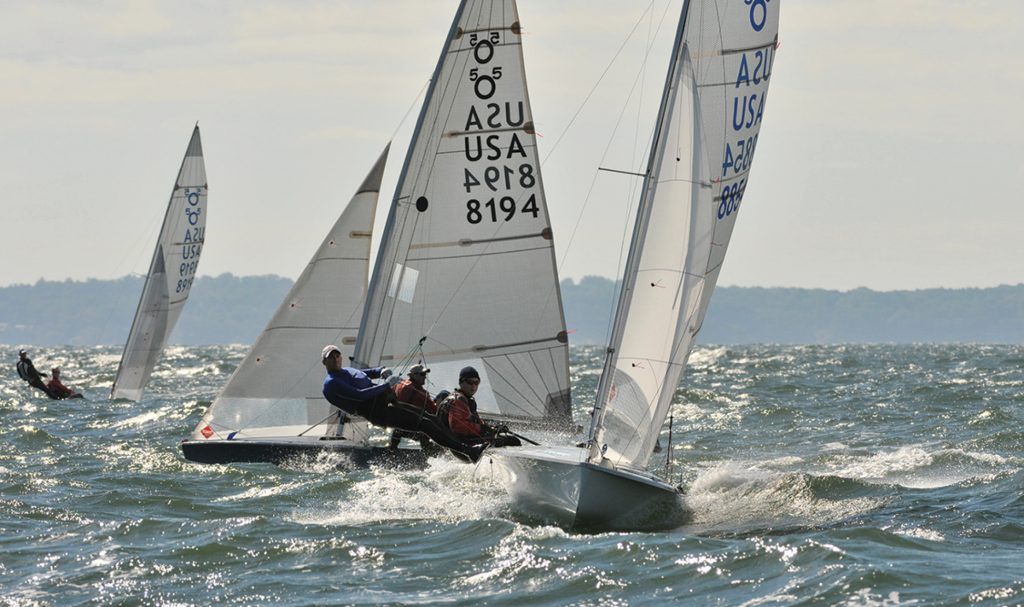By David Dellenbaugh

The second beat is late enough in the race to protect your position by covering the rest of the fleet, but usually still too early to focus only on one or two other boats (unless you’re near the windward mark). © Allen Clark/PhotoBoat.com
Strategizing for the second beat is a lot like planning for any other leg. your strategy (the plan you make for getting to the windward mark as quickly as possible) should be in place before you round the leeward mark. It doesn’t have to be too complicated, but it should consider a number of factors like wind velocity, wind shifts, current, waves and the location of the next mark (but not the presence or actions of your competitors).
One of the good things about planning for the second beat is that you can draw from a lot of recent history. Since you’ve been racing for at least the last half hour, think back on patterns you’ve been seeing in wind velocity and direction. What do you think the wind will do for the next 15 or 20 minutes?
Often you can use information about what happened on the first beat. If the boats that were leading at the windward mark all came from the right side, for example, then you should probably consider that side on the second beat (especially if their gain was due to a geographic wind effect). You shouldn’t just blindly bang the right corner, though, because the wind conditions are always changing – and maybe the left side will be favored this time.
You can also use your observations from the run or reach you just sailed. You have to be careful, though, because it’s usually harder to keep track of windshifts when you’re going down- wind. Also, sometimes the side of the course that’s favored on a run will be unfavored on the next beat. This could happen, for example, when gains are due to current or to persistent shifts in wind direction.
After you collect your thoughts about the second windward leg, piece together a mental gameplan. This could be as simple as “go left” or “go right.” You just need some- thing to keep you on track as you sail up the beat. Let’s say, for example, that you’re on port tack, converging with a starboard tacker. You decide to keep clear by tacking, but as soon as you get on starboard tack you realize that you are now headed for the wrong side of the course. If you had been thinking “go right” as you approached the other boat, you could have ducked them and kept going toward the favored side. Here are some other tips and ideas about strategizing on the second beat.
Keep reevaluating your plan.
Remember that the wind and other variables are always changing. The plan that you put together before the leeward mark may no longer be valid when you are half way up the leg. So keep your head out of the boat. One good thing about the second beat is that the fleet gets pretty spread out and there are boats all over the course to help you see windshifts and identify which side is paying off.
Besides choosing a side of the course, you must decide whether you will play the windshifts as oscillating or persistent. This is a key part of your strategy on any leg, especially on the second beat because it is relatively long. If you think changes in the wind direction are oscillating but they are really persisting, or vice versa, then you will lose a lot of distance.
Follow basic principles.
There are some strategic rules of thumb that seem to work on every leg of the race. These are especially important for the second beat where the fleet gets spread out.
- Sail the longer tack first. By sailing on the tack where your bow is pointed closer to the wind- ward mark, you’ll stay away from the corners of the course. More important, you will increase your odds of benefitting from the next windshift, especially when you’re not sure which way it will go.
- Stay away from laylines. This is really a corollary of the principle above because you won’t get to a layline if you sail the longer tack. Laylines are usually bad because once you get there you can’t play the shifts any more, and other boats may tack on you. Of course, you can’t avoid the laylines forever (or you’ll never get to the mark) – just try not to spend too much time on your final approach.
- Sail toward the next shift. If you can figure out where the wind will shift next, just sail in that direction and you will end up on a higher ladder rung. This works for both shifty and persistent winds. ■
This article originally appeared in David Dellenbaugh’s Speed & Smarts, The newsletter of how-to tips for racing sailors. If you want to sail faster and smarter, log onto SpeedandSmarts.com.
A resident of Easton, CT, Dellenbaugh was tactician and starting helmsman for America3’s successful defense of the America’s Cup in 1992. He’s a Lightning World Champion, two-time Congressional Cup winner, seven-time Thistle National Champion, two-time winner of the Canada’s Cup, three-time Prince of Wales U.S. Match Racing Champion, and a winner of the U.S. Team Racing Championships for the Hinman Trophy.




